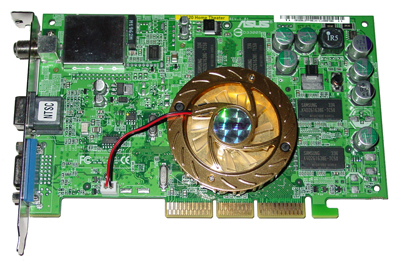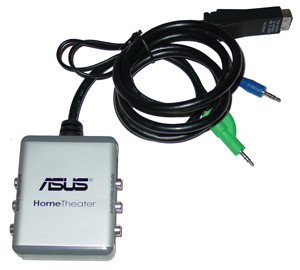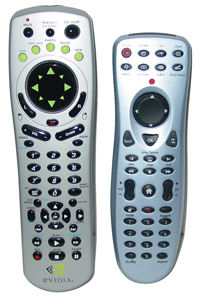NVIDIA GeForce FX Personal Cinema Roundup - Asus, Chaintech, eVGA, and MSI
by Andrew Ku on December 23, 2003 10:48 AM EST- Posted in
- GPUs
Asus V9520 Home Theater — Hardware
Asus is the only manufacturer in this roundup that has taken many risks by deviating from the reference design in both hardware and software. Instead of producing a card that is dual display supported, Asus has decided to strip out the components necessary to enable dual displays. The breakout box is identical to the reference design, but it lacks the second VGA adapter and has the Asus logo instead of NVIDIA's. Because Asus has re-dubbed Personal Cinema to be their Home Theater line, they are, effectively, pushing the name where they can, which includes the breakout cable. This is because Asus means to differentiate themselves from the rest of the crowd and is nothing more than marketing semantics.Simply using a reference cable on the Asus card will not provide dual display support because the card itself isn't designed to support it. This choice was made mainly to save money, which is an option provided to NVIDIA's Personal Cinema partners, most of whom have seem to have decided to employ dual display support.
Asus doesn't use the NVRemote in their Home Theater line up, instead opting to use their IR remote. This choice seems to be understandable, since it would help generate money as Home Theater gains more momentum. However, the risk for this product line is now on Asus' shoulders. If Asus had chosen the remote from NVIDIA, low sales of the Home Theater product would effectively hamper the sales of NVIDIA's remote. Since it is Asus' proprietary remote, the profit made from the remote will go to Asus, but this will be dependent on sales of their product.
The remote feels shockingly comfortable and natural. The casing and buttons feels very similar to the feel of a TV remote. Though, the buttons lack some tactile response. The directional mouse pad specifically is hard to use because it is sensitive without providing good feedback. Compounding the effect is the lack of a software configuration utility to edit preferences or program buttons on the remote. However, its small profile makes us more compelled to use this instead of NVIDIA's remote.
Because Asus uses IR protocol for their remote, it means that the base will need to be placed within the line of sight of the user. This is perfectly fine for this product, so long as it isn't used to clone on a TV in the adjacent room.














6 Comments
View All Comments
Webgod - Sunday, January 11, 2004 - link
Where's the review? Where's the comparison of screenshots of live TV with both the Personal Cinema and ATI AIW cards? How does it compare to your TV set side by side? How do the ATI AIW's compare to the Personal Cinema cards with PVR functions, etc.? Go more in depth, this is Anandtech.bschuler2004 - Monday, December 29, 2003 - link
Nvidia sure does make some crappy AIW imitators! I thought they'd be worse than ATI, but not THIS bad. It's shocking to say the least. I'd rather have an original AIW rage IIC card then one of these garbage cards.How on earth do they honestly intend to sell this junk with a straight face? It's laughable.
jruff - Wednesday, December 24, 2003 - link
PC CLub recommened the nVidia card which is what I built for my mothers computer. Going over tomorrow t o run thru the software. For my wife's machine I just bought a AIW 9600 Pro that I will be installing tomorrow. Shhhh, its a christmas present ;)I couldnt find much on the nVidia when I put her new system together I was just going on what PC Club said. Ill get a chance to use both here in the next week putting together the 6 Digital 8 tapes I have managed to make in the last year of my sons life (birthday jan 8, 1 year)
We will se how it goes and which makes the easiest final product.
Stay tuned :)
LoneWolf15 - Wednesday, December 24, 2003 - link
Interesting, but I do get a little tired of bundling all of these products with the video card. I want to keep a TV tuner/PVR for the long haul, and every time graphics technology changes, buying a new all-in-one card would break my budget. That, and the fact that NVidia only offers these features on their low-end cards means I'd rather choose one of ATI's solutions, despite some issues with their software. The All-in-Wonder line now spans from the entry-level AIW 7500 and 9000 on up to the top. ATI has a much better tiered structure, and also has standalone tuner/capture cards (TV Wonder Pro).morcegovermelho - Tuesday, December 23, 2003 - link
Good review. Very good info on breakout box, remote control, and Dual Display Support.Maybe should be included in the review some info about video-capture.
What capture format? MPEG2? AVI? Other format?
If capture is mpeg2, what resolution? what bitrate? Is it DVD-compliant?
If capture is avi, what is the codec? Can it be uncompressed? Can we use DivX? It's a proprietary codec?
How about dropped frames?
Audio capture - 44khz or 48Khz? Uncompressed, mp2 or ac3 ?
sandorski - Tuesday, December 23, 2003 - link
I just kinda skimmed the article, but I saw enough to support my conclusion(I think ;) ): Nvidia has a long road to catch up to ATI in regards to Multimedia/Multifunction vidcards. It's not just in technology though, but also reputation.It wasn't too long ago when Multifunction was all ATI had, they certainly weren't selling their cards for Gaming Performance reasons. No serious Gamer would even consider them.
OTOH Nvidia and 3DFX were engaged in a bitter battle for the Gaming Performance crown. We all know how that turned out ( :( ).
Nvidia won the Crown and all seemed good....until ATI released the Radeon 9700 Pro. That one card turned the video card world on its' ear and NVidia has been trying to catch up since.
ATI's time relying on and perfecting their AIW and lesser MultiMedia functioning cards had allowed them to focus on Gaming Performance. They acheived that and the Marketplace is begining to turn on to the whole Multimedia/Multifunction idea in a big way.
Nvidia has a long road ahead and seems to be trying to desperately catch up on a number of fronts. Hopefully they can for Competitions sake, but ATI is turning into a Juggernaut.